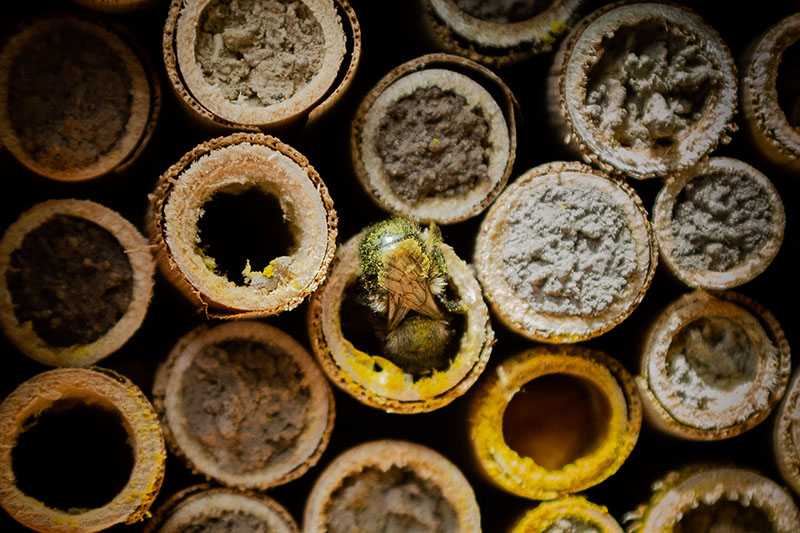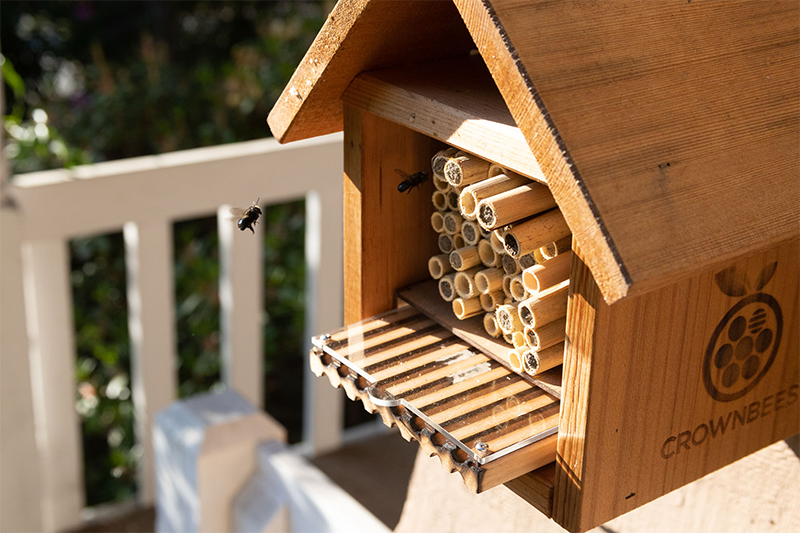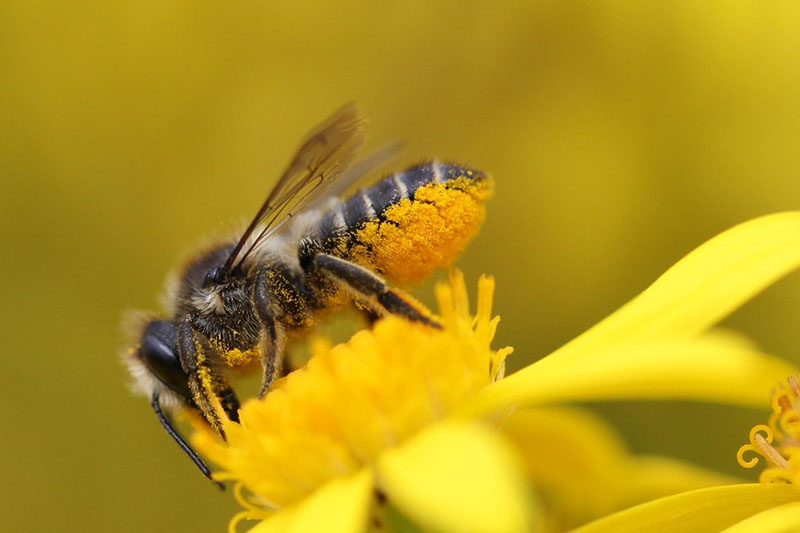
What are solitary bees?
Of the 20,000 + bee species globally, less than 10% are social bees like honey bees and bumble bees. The other 90% are solitary bees. As you may have guessed, solitary bees live independently, not in colonies with a queen and workers like honey bees and bumble bees. Each female builds her nest, collects her pollen and nectar, and lays her eggs without any help from other bees. One could say that each solitary female bee is a queen!
Fun Fact: The Crown Bees name was born from the idea that every solitary female bee is a queen and therefore deserves a crown!
Where do solitary bees live?
Globally, 70% of our native solitary bee species nest in the ground, laying their eggs in tunnels just below the surface. The remaining 30% of native solitary bees are cavity-nesting bees. Cavity-nesting bees build their nests inside tunnels left behind by insects, in the hollow stems of certain plants, and artificial bee houses and hotels. Most cavity-nesting bee species don't cause damage to your deck or home because they nest in pre-made holes instead of boring into wood.
Fun Fact: As their common name suggests, carpenter bees are an exception and can cause damage by boring into eaves, rafters, decks, and furniture.
Since cavity-nesting bees nest above ground and will readily nest in artificial structures, we can easily raise solitary bees, both managed and native species, in our backyards. Healthy populations of solitary bees are a great way to increase pollination rates in your yard and garden!

How do solitary bees find nesting tubes?
Cavity-nesting bees use sight and smell to select and locate their nesting tubes.
Mason and leafcutter bees often choose to nest in locations that have pheromone scents left behind by other bees. In partnership with the USDA, Crown Bees holds the patent license for InvitaBee™Plus+ Mason Bee Attractant. The attractant is used to encourage the nesting of all bees in the genus Osmia (about 350 species worldwide) and reduce the incidences of dispersal.
For leafcutter bees, we have InvitaBee™ Spray Leafcutter Bee Attractant . After a series of internal experiments, we've perfected an artificial pheromone that "smells like home" to summer leafcutter bees. In all of our trials, the bees preferred nesting materials treated with InvitaBee™ over untreated nesting materials.
Bees also use visual cues to help orientate themselves to their nests.
After emerging from their cocoons, females will mate, then take an orientation flight. During this flight, she'll search for a suitable nesting site and learns the surrounding area to help her relocate her nest when she returns from foraging. After selecting a nesting tube, the female bee will fly in a zigzag pattern in front of the nest entrance, memorizing its exact location. After remembering the nest location, she'll become disoriented if the nest is moved—often causing her to abandon it altogether. For this reason, we don't recommend moving the bee house or shuffling around nesting materials once the bees begin to fly! If you have a super productive nest and need to replace capped-nesting tubes with new ones, make sure you keep all unfilled and partially filled nesting tubes in the exact location within the nest.
Fun Tip: Include a few colorful art objects with the nesting materials or paint a design on a handful of nesting holes to help the females easily locate their nests. Just make sure you allow plenty of time for the materials to air out before bees emerge, otherwise; the scent may deter them from nesting.
Do solitary bees sting?
Solitary bees do not need to defend hives or stores of honey and wax. Despite having a stinger, solitary female bees are gentle and rarely sting, even when handled, making them safe around kids and pets.
If you get stung, it's much less painful than a sting from a social bee - people stung by solitary bees liken the pain to that of a mosquito. As a result, solitary bees raisers do not need any special protective equipment!
Fun Fact: Even among bee species with more aggressive tendencies, such as honey bees and bumble bees, males cannot sting! They may engage in defensive behavior to protect the hive or nest, but they will not be able to sting you!
What are the pollination advantages of solitary bees?
As you can imagine, different bee species use different methods to collect pollen and nectar, each with its advantages. To keep this section simple, we'll only focus on the differences in foraging behavior between solitary mason and leafcutter bees and social honey bees.
Fun Fact: Solitary bees like mason and leafcutter bees pollinate around 95% of the flowers they visit, whereas honey bees generally only pollinate about 5% of the flowers they visit.
Pollen Collection
One significant difference between solitary bees, such as mason and leafcutter bees, and honey bees, is the way they gather pollen. Honey bees gently land on blossoms and collect pollen on their bodies, mix it with saliva, creating a paste, and store it in saddlebags on their hind legs. Securing the pollen in these saddlebags doesn’t allow for effective pollination.
Solitary bees like mason and leafcutter bees carry dry, loose pollen on special Scopa hairs on the underside of their bellies. The pollen sticks all over their bodies like Velcro and is more likely to fall off as they belly flop from flower to flower, aiding in pollination.

Cross-Pollination
Many plants need to be pollinated by pollen from another plant, and this is called cross-pollination. Solitary bees work alone as rogue agents, meandering between plants, visiting flowers that give off the best pollen and nectar signals. This meandering behavior facilitates cross-pollinators!
The honey bee is a meticulous and well-coordinated flower visitor, flying from blossom to blossom, but will often return to the same tree, resulting in low cross-pollination rates.
Complex Flowers
Some flowers have evolved unique ways of ensuring they are pollinated a certain way. E.g., plants in the legume family.
Many legumes consist of one large central petal, two side petals, and fused bottom petals called a keel. These complex flowers are more difficult to open. The keel petals enclose the stamen column under tension. When these petals are slightly separated by a bee searching for pollen, the pressure is released or "tripped." Pollination cannot occur unless the keel is tripped.
When tripped, bees are often struck on the head by the stamen column with a great deal of force and dusted with pollen in the process. Honey bees often seek out more accessible food sources. Leafcutter bees are well adapted to these unusual flowers and are not deterred.
Fun Fact: Alfalfa is a legume. The alfalfa industry relies heavily on the industrious little leafcutter bee!
Cool, Rainy, and Longer Days
Solitary bees work alone and need to build their nests and lay eggs before their short lives are over. Mason bees are among the earliest bee species to emerge in the spring, making them essential for spring crops. They often forage in low light levels, cool temps, and wet weather, whereas honey bees tend to be fair weather pollinators.
Fun Fact: On average, mason bees forage 2x longer per day than honey bees.
The ABCs of Raising Solitary, Cavity-Nesting Bees ~ 4 mins.
Solitary bees like mason and leafcutter bees are the perfect pollinators for backyard gardens, farms, and orchards because they are gentle, easy to raise, and fun to watch. Plus, as we mentioned above, they are super cross-pollinators that can double or even triple your yields! Watch this short video to learn more!


